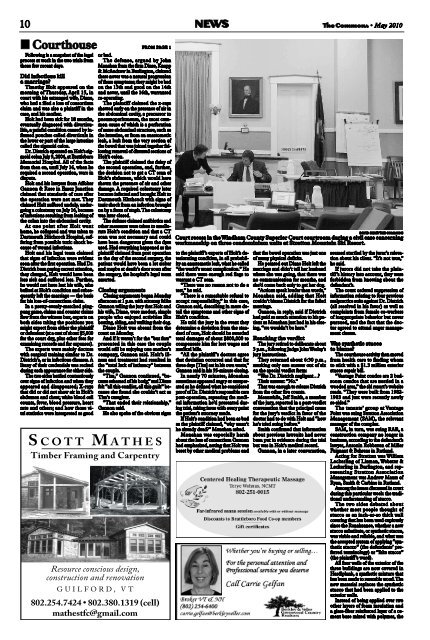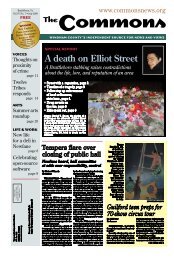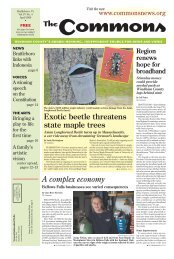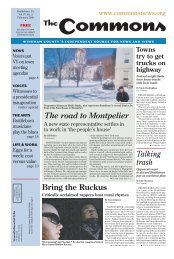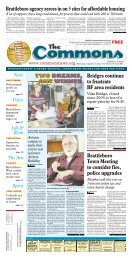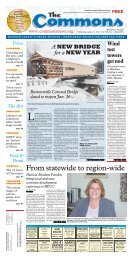neWs - The Commons
neWs - The Commons
neWs - The Commons
Create successful ePaper yourself
Turn your PDF publications into a flip-book with our unique Google optimized e-Paper software.
10 NEWS <strong>The</strong> <strong>Commons</strong> • May 2010 <strong>The</strong> <strong>Commons</strong> • May 2010 NEWS 11<br />
n Courthouse from page 1<br />
Following is a snapshot of the legal<br />
process at work in the two trials from<br />
those few recent days.<br />
Did infections kill<br />
a marriage?<br />
Timothy Holt appeared on the<br />
morning of Thursday, April 15, in<br />
court with his estranged wife, Diane,<br />
who had a filed a loss of consortium<br />
claim and was also a plaintiff in the<br />
case, and his mother.<br />
Holt had been sick for 18 months,<br />
eventually diagnosed with diverticulitis,<br />
a painful condition caused by inflamed<br />
pouches called diverticula in<br />
the lower or part of the large intestine<br />
called the sigmoid colon.<br />
Dr. Dietrich operated on Holt’s sigmoid<br />
colon July 9, 2004, at Brattleboro<br />
Memorial Hospital. All of the facts<br />
from then on, until July 16, when he<br />
required a second operation, were in<br />
dispute.<br />
Holt and his lawyers from Affolter<br />
Gannon & Rose in Essex Junction<br />
claimed that standards of care after<br />
the operation were not met. <strong>The</strong>y<br />
claimed Holt suffered unduly, undergoing<br />
a colostomy on July 16, because<br />
of infections resulting from leaking of<br />
the colon into the abdominal cavity.<br />
At one point after Holt went<br />
home, he collapsed and was taken to<br />
Dartmouth Hitchcock Hospital, suffering<br />
from possible toxic shock because<br />
of wound infections.<br />
Holt and his legal team claimed<br />
that signs of infection were evident<br />
soon after the first operation. Had Dr.<br />
Dietrich been paying correct attention,<br />
they charged, Holt would have been<br />
less sick and suffered less. Further,<br />
he would not have lost his wife, who<br />
balked at Holt’s condition and subsequently<br />
left the marriage — the basis<br />
for his loss-of-consortium claim.<br />
In a pretty-evenly-matched pingpong<br />
game, claims and counter claims<br />
flew from the witness box, experts on<br />
both sides taking the positions you<br />
might expect from either the plaintiff<br />
or defendant (at a cost of about $5,000<br />
for the court day, plus other fees for<br />
examining records and for expenses).<br />
<strong>The</strong> experts were mainly doctors<br />
with surgical training similar to Dr.<br />
Dietrich’s, or in infectious diseases. A<br />
litany of their credentials was recited<br />
during each appearance for either side.<br />
<strong>The</strong> two sides battled contentiously<br />
over signs of infection and when they<br />
appeared and disappeared; X-rays<br />
that did or did not show air in Holt’s<br />
abdomen and chest; white blood cell<br />
counts, fever, blood pressure, heart<br />
rate and others; and how those vital<br />
statistics were interpreted as good<br />
S COTT M ATHES<br />
Timber Framing and Carpentry<br />
Resource conscious design,<br />
construction and renovation<br />
GUILFORD, VT<br />
or bad.<br />
<strong>The</strong> defense, argued by John<br />
Monahan from the firm Dinse, Knapp<br />
& McAndrew in Burlington, claimed<br />
there never was a natural progression<br />
of these symptoms; they might be bad<br />
on the 13th and good on the 14th<br />
and never, until the 16th, warranted<br />
re-operating.<br />
<strong>The</strong> plaintiff claimed the x-rays<br />
showed early on the presence of air in<br />
the abdominal cavity, a precursor to<br />
pneumoperitoneum, the most common<br />
cause of which is a perforation<br />
of some abdominal structure, such as<br />
the intestine, or from an anastomotic<br />
leak, a leak from the very section of<br />
the bowel that was joined together following<br />
removal of diseased sections of<br />
Holt’s colon.<br />
<strong>The</strong> plaintiff claimed the delay of<br />
the second operation, and, further,<br />
the decision not to get a CT scan of<br />
Holt’s abdomen, which would have<br />
shown the presence of air and other<br />
damage. A required colostomy later<br />
became infected and brought Holt to<br />
Dartmouth Hitchcock with signs of<br />
toxic shock from an infection brought<br />
on by a form of staph. <strong>The</strong> colostomy<br />
was later closed.<br />
<strong>The</strong> defense claimed antibiotics and<br />
other measures were taken to ameliorate<br />
Holt’s condition and that a CT<br />
scan was not necessary and could<br />
have been dangerous given the dyes<br />
used. Had everything happened as the<br />
plaintiff claimed from post operation<br />
to the day of the second surgery, the<br />
patient would have been a lot sicker<br />
and maybe at death’s door soon after<br />
the surgery, the hospital’s legal team<br />
asserted.<br />
Closing arguments<br />
Closing arguments began Monday<br />
afternoon at 1 p.m. with attorney Mike<br />
Gannon telling the jury that Holt and<br />
his wife, Diane, were modest, simple<br />
people who enjoyed activities like<br />
boating, skiing, and walking their dog.<br />
Diane Holt was absent from the<br />
court on Monday.<br />
And if it weren’t for the “but fors”<br />
presented in this case the couple<br />
would still be enjoying one another’s<br />
company, Gannon said. Holt’s illness<br />
and treatment had resulted in<br />
the “total lack of intimacy” between<br />
the couple.<br />
“Tim,” Gannon continued, “became<br />
ashamed of his body,” and Diane<br />
felt “all this conflict, all this guilt” because<br />
she found she couldn’t act as<br />
Tim’s caregiver.<br />
“That ended their relationship,”<br />
Gannon said.<br />
He also spoke of the obvious signs<br />
802.254.7424 • 802.380.1319 (cell)<br />
mathestfc@gmail.com<br />
DAVID SHAW/THE COMMONS<br />
Court recess in the Windham County Superior Court courtroom during a civil case concerning<br />
workmanship on three condominium units at Stratton Mountain Ski Resort.<br />
to the plaintiff’s experts of Holt’s deteriorating<br />
condition, in all probability<br />
an anastomotic leak, what he called<br />
“the world’s worst complication.” He<br />
said there were enough red flags to<br />
warrant a CT scan.<br />
“<strong>The</strong>re was no reason not to do a<br />
test,” he said.<br />
“<strong>The</strong>re is a remarkable refusal to<br />
accept responsibility,” in this case,<br />
Gannon said, describing in more detail<br />
the symptoms and other signs of<br />
Holt’s condition.<br />
He told the jury in the event they<br />
determine a deviation from the standard<br />
of care, Holt should be awarded<br />
total damages of about $800,000 to<br />
compensate him for lost wages and<br />
medical bills.<br />
“All the plaintiff’s doctors agree<br />
that deviation occurred and that for<br />
three days [Tim] sat in his own waste,”<br />
Gannon said in his 35-minute closing.<br />
In nearly 70 minutes, Monahan<br />
sometimes appeared angry or exasperated<br />
as he defined what he considered<br />
proof of Dr. Dietrich’s responsible care<br />
post-operation, repeating the medical<br />
information he’d presented during<br />
trial, taking issue with every point<br />
the patient’s attorney made.<br />
If Holt’s condition had been as bad<br />
as the plaintiff claimed, “why wasn’t<br />
he already dead?” Monahan asked.<br />
Monahan was especially harsh<br />
about the loss of consortium Gannon<br />
had emphasized, noting that Holt was<br />
beset by other medical problems and<br />
that the bowel operation was just one<br />
of many physical deficits.<br />
He pointed out Diane Holt left the<br />
marriage and didn’t tell her husband<br />
where she was going, that there was<br />
no communication for months, and<br />
she’d come back only to get her dog.<br />
“Actions speak louder then words,”<br />
Monahan said, adding that Holt<br />
couldn’t blame Dietrich for the failed<br />
marriage.<br />
Gannon, in reply, said if Dietrich<br />
had paid as much attention to his patient<br />
as Monahan just had in his closing,<br />
“we wouldn’t be here.”<br />
Reaching the verdict<br />
<strong>The</strong> jury retired to deliberate about<br />
3 p.m., following Judge John Wesley’s<br />
jury instructions.<br />
<strong>The</strong>y returned about 6:30 p.m.,<br />
marking only one answer out of six<br />
on the special verdict form:<br />
“Was Dr. Dietrich negligent…?<br />
<strong>The</strong>ir answer: “No.”<br />
That was enough to release Dietrich<br />
from the other five counts.<br />
Meanwhile, Jeff Smith, a member<br />
of the jury, reported in a post-verdict<br />
conversation that the principal cause<br />
for the jury’s verdict in favor of the<br />
doctor had to do with Holt and “how<br />
he’s tried suing before.”<br />
Smith confirmed that information<br />
about previous lawsuits had never<br />
been put in evidence during the trial<br />
but was in Holt’s medical record.<br />
Gannon, in a later conversation,<br />
seemed startled by the juror’s relevation<br />
about his client. “It’s not true,”<br />
he said.<br />
If jurors did not take the plaintiff’s<br />
history into account, they were<br />
forbidden from knowing about the<br />
defendant’s.<br />
<strong>The</strong> court ordered suppression of<br />
information relating to four previous<br />
malpractice suits against Dr. Dietrich<br />
(all resolved in his favor) as well as<br />
complaints from female co-workers<br />
of inappropriate behavior but never<br />
pursued, and the fact that the doctor<br />
agreed to attend anger management<br />
classes.<br />
Was synthetic stucco<br />
to blame?<br />
<strong>The</strong> courthouse activity then moved<br />
from health care to finding whom<br />
to stick with a $1.3 million exterior<br />
stucco repair bill.<br />
“Vantage Point condos are 2 bedroom<br />
condos that are nestled in a<br />
wooded area,” the ski resort’s website<br />
reads. “<strong>The</strong>y were built from 1982-<br />
1983 and just were recently newly<br />
re-sided.”<br />
<strong>The</strong> tenants’ group at Vantage<br />
Point was suing Stratton Association<br />
Management (SAM), the relevant<br />
manager of the complex.<br />
SAM, in turn, was suing RAB, a<br />
construction company no longer in<br />
business, according to the defendant’s<br />
lawyer, Antonin Robbason of Miller<br />
Faignant & Behrens in Rutland.<br />
Acting for Stratton was William<br />
Leckerling of Lisman, Webster &<br />
Leckerling in Burlington, and representing<br />
Stratton Association<br />
Management was Andrew Maass of<br />
Ryan, Smith & Carbine in Rutland.<br />
Among the issues discussed in court<br />
during this particular week: the traditional<br />
understanding of stucco.<br />
<strong>The</strong> two sides debated about<br />
whether most people thought of<br />
stucco as an inch-or-so thick wall<br />
covering that has been used copiously<br />
since the Renaissance, whether a new<br />
stucco substitute, or synthetic stucco,<br />
was viable and reliable, and what was<br />
the accepted system of applying “synthetic<br />
stucco” (the defendants’ preferred<br />
terminology) or “fake stucco”<br />
(the plaintiff’s word).<br />
All four walls of the exterior of the<br />
three buildings are now covered in<br />
Hardiplank, a synthetic mixture that<br />
has been made to resemble wood. <strong>The</strong><br />
new material replaces the synthetic<br />
stucco that had been applied to the<br />
exterior walls.<br />
Instead of being applied over two<br />
other layers of foam insulation and<br />
a glass-fiber reinforced layer of a cement<br />
base mixed with polymer, the<br />
synthetic stucco had been applied on<br />
top of the plywood siding of the building,<br />
which had been covered only by<br />
a layer of mesh, according to expert<br />
architects and builders testifying for<br />
the prosecution.<br />
<strong>The</strong> two-bedroom condos, over<br />
their life in boom and bust economies,<br />
have ranged in price from about<br />
$110,000 to upwards of $275,000.<br />
<strong>The</strong>y all sold, and subsequently, many<br />
have been resold.<br />
<strong>The</strong> direct application of the synthetic<br />
stucco to the mesh and plywood<br />
siding caused rot and leaks, as well as<br />
worse problems in areas around doors,<br />
and windows, and flashing.<br />
Doors and windows must be sealed<br />
to prevent water from seeping behind<br />
the outer layer of synthetic<br />
stucco, a measure that was not done<br />
or not done properly, according to<br />
the plaintiff.<br />
<strong>The</strong> plaintiff argued it had been<br />
more expensive to replace the defective<br />
stucco than it would have been to<br />
do it right to begin with.<br />
But, the defense argued, the repair<br />
work far exceeded the scope of repairing<br />
the damage.<br />
<strong>The</strong> defense argued that judging<br />
24-year-old buildings by modern<br />
standards and codes was wrong and<br />
defended the synthetic stucco. “This<br />
product performed pretty darn well<br />
for 25 years,” the defense claimed.<br />
<strong>The</strong> plaintiff took the position that<br />
damage to the building began many<br />
years ago and had required many<br />
repairs.<br />
Keeping the water out<br />
An expert witness for the plaintiff,<br />
Peter Morgan, a contractor and a<br />
builder, testified that he had done repair<br />
work at the complex and believed<br />
the system used to apply the synthetic<br />
stucco was faulty.<br />
“<strong>The</strong> basics of the system are incompatible,”<br />
Morgan said. “You must<br />
keep moisture off the wood.”<br />
He also said he had reported this<br />
flaw to Kathy Harper, a Stratton employee<br />
and at the time in charge of<br />
maintenance at the condo complex,<br />
and was unaware if she reported that<br />
to anyone.<br />
Another plaintiff expert witness,<br />
architect Albert Russell, reiterated<br />
Morgan’s view but allowed that using<br />
the three-layered system — of insulation<br />
and cement and mesh and then<br />
synthetic stucco — would work if applied<br />
properly. He drew for the jury<br />
a diagram of how to properly apply<br />
synthetic stucco.<br />
Asked what he had found on the<br />
Vantage Point buildings, he replied,<br />
“No building paper [one of the layers<br />
in one of the synthetic stucco systems],<br />
no insulation, no mesh. It was not appropriate.<br />
Moisture rots out framing<br />
and causes mold.”<br />
How long would it take to<br />
deteriorate?<br />
“<strong>The</strong> problems would have started<br />
immediately; sometimes it takes years<br />
to show up,” Russell testified.<br />
<strong>The</strong> defense strategy seemed to focus<br />
more on the extent of the repairs<br />
than on the relative value of synthetic<br />
stucco, with lawyers asking Russell<br />
if the public, by looking at the walls,<br />
would be able to tell if it was synthetic<br />
stucco. <strong>The</strong> architect thought<br />
one could.<br />
<strong>The</strong> defense showed a picture of<br />
a wall with windows that displayed<br />
an obvious seam where the imitation<br />
stucco was joined. Mr. Russell said,<br />
“That’s a clue this is not stucco.”<br />
R i v e R b e n d<br />
R i v e R b e n d<br />
FaRm SupplieS<br />
FaRm Pet Food, Bird Seed, Equine, SupplieS<br />
Pet and Stable Supplies,<br />
A busy courthouse, a rich heritage<br />
NEWFANE—<strong>The</strong> elegant federal/Greek<br />
revival Windham County<br />
Courthouse, with its four imposing<br />
Doric columns guarding the entrance,<br />
began its life rather differently<br />
in 1925, as a simpler structure<br />
on the green.<br />
Several renovations later it began<br />
taking its current shape, including<br />
in 1854 when the four-column portico<br />
was added, and in 1907, when<br />
additions to the western end of the<br />
building provided space for judge’s<br />
chambers and for a lawyer’s room.<br />
That was also when the famous<br />
upstairs courtroom was decorated<br />
with not only a pressed-tin ceiling<br />
but with an elaborately designed,<br />
pressed-tin cornice in various shades<br />
of green that encircles the large<br />
room, extending around the balcony<br />
at the rear.<br />
Paintings, engravings, and photographs<br />
of well-known Vermont<br />
jurists also circle the room. For example,<br />
one such picture behind the<br />
judge’s chair, is of Newfane native<br />
Roswell Martin Field, 1807-1869.<br />
He was state’s attorney for many<br />
years before moving to St. Louis,<br />
where he defended escaped slave<br />
Dred Scott before the Missouri<br />
Supreme Court.<br />
<strong>The</strong> chairs and tables in the<br />
room date from appropriate periods.<br />
One glass-topped table, behind<br />
the lawyers’ tables, features,<br />
beneath the glass, a photograph<br />
and history of the U.S.S. Windham<br />
County, an LST 1170 tank landing<br />
ship, launched May 1954, built<br />
in Wisconsin, and sponsored by<br />
Jean Kerr McCarthy, the wife of<br />
Senator Joseph McCarthy. It was<br />
used mostly for troop and supply<br />
Performance in court<br />
Friday afternoon continued with<br />
testimony from a condo owner who<br />
was also, for sometime, president of<br />
the condo board, and from another<br />
condo owner who had died after his<br />
deposition was taken.<br />
Patrick Monroe, a part-time actor<br />
recruited by the plaintiff, read the<br />
deceased’s deposition for the court.<br />
Monroe brought the courtroom up<br />
short with his quiet performance of<br />
an 82-year-old man, a retired banker,<br />
who’d bought a condo for $111,725<br />
some 25 years before and who had no<br />
use at all for the shenanigans the deposition<br />
questions seemed to imply.<br />
He’d looked at other condos but<br />
knew he wanted the one he bought<br />
at Vantage Point.<br />
“I had a lot of confidence and<br />
trust. <strong>The</strong>re was an aura of strength<br />
at Stratton. <strong>The</strong> main thing was trust<br />
and the price. We were downsizing<br />
from a house on the mountain, and<br />
you have this belief here about who’s<br />
running the show.”<br />
<strong>The</strong> verdict<br />
After another four days, the trial<br />
of Vantage Point Condominium<br />
Association against Stratton<br />
Management Association ended, and<br />
the jury awarded Vantage Point more<br />
than $1.4 million in the late afternoon<br />
of April 29. <strong>The</strong> third-party defendant<br />
in the case, RAB, was not held liable.<br />
Court officers said they thought this<br />
the largest jury award in Windham<br />
Superior Court.<br />
Tack, Hay & Riverdale Shavings, Road, Poulin Townshend<br />
Grain<br />
Riverdale 802-365-7800 Road, Townshend<br />
Riverdale behind Monday–Friday the River Road, Bend 9 a.m.–5 Townshend<br />
Farm p.m. Market<br />
Saturday 10 a.m.–2 p.m.<br />
802-365-7800<br />
Monday–Friday 9 a.m.–5 p.m.<br />
Saturday 10 a.m.–2 p.m.<br />
<strong>The</strong> Windham County Courthouse on the Newfane green.<br />
movements and decommissioned in<br />
June 1973 when it was transferred<br />
to Turkey.<br />
Nearly 700 civil cases are heard<br />
annually in Windham County<br />
Superior Court and between 900<br />
and 1,000 small claims cases, presided<br />
over by temporary judges who<br />
sign on for that duty.<br />
Superior court judges are assigned<br />
to certain rotations; Windham shares<br />
a presiding judge with Bennington.<br />
Judge John Wesley is finishing the<br />
first period of his rotation and has<br />
been assigned to Windham for the<br />
next period. Between trials, Judge<br />
Wesley may hear motions that precede<br />
trials and generally relate to<br />
such issues as landlord/tenant disputes<br />
and property conflicts.<br />
<strong>The</strong> superior court meets one<br />
month on and one month off and<br />
during the off months the court<br />
hears small claims cases, or the room<br />
may be used by other courts.<br />
<strong>The</strong> delicate stairway to the second<br />
floor precludes a ramp for the<br />
handicapped so when any party to<br />
a trial is unable to get to the courtroom,<br />
another courtroom is found.<br />
Richard Carroll is clerk of the<br />
court and is charged with managing<br />
Member FDIC<br />
Equal Housing Lender<br />
JEFF POTTER/THE COMMONS<br />
all the details of the courtroom and<br />
the process, such as sending notices<br />
to potential jurors, sending subpoenas,<br />
and keep track of all that the<br />
judge may need or want.<br />
Chuck LaValle is the court officer,<br />
who is charged with protecting the<br />
judge and managing the jury.<br />
Nissa Petrak is the court reporter,<br />
who keeps tracks of all the exhibits<br />
and the tape recorder that keeps the<br />
record of the trial. She says she’d like<br />
to keep using the tape recorder and<br />
has no wish for a digital conversion.<br />
This area’s only remaining<br />
truly local<br />
communiTy bank<br />
Main Office: 221 Main Street, Brattleboro | 85 Main Street, Springfield<br />
Perkins Home Center: 99 Route 9, W. Chesterfield, NH


